Key takeaways:
- Hospital ministry emphasizes the importance of presence, emotional release, and compassionate support for patients, significantly impacting their healing process.
- Emotional release through sharing fears and feelings fosters connections and promotes healing, as seen in various patient interactions.
- Faith provides comfort and a sense of community during vulnerable times, enhancing emotional well-being and facilitating healing through connection and prayer.
- Building a support network is essential for emotional release, allowing individuals to share experiences and find strength in collective vulnerability.

Understanding Hospital Ministry
Hospital ministry serves as a bridge between healthcare and spiritual care, offering comfort during some of life’s most vulnerable moments. I recall visiting a friend in the hospital, feeling the heavy air of uncertainty. The hospital chaplain stepped in, offering words that seemed to lift not just my friend’s spirit but also the burdens we all carried that day.
In my experience, the essence of hospital ministry is about presence. It’s not always the big gestures that matter; sometimes, it’s just sitting quietly with someone and letting them know they are not alone. Have you ever felt that profound relief when someone simply listens? That sense of being seen can be powerful in a sterile hospital room filled with beeping machines.
The role of a hospital minister extends beyond prayer and scripture; it involves listening to patients’ fears and doubts. I remember when I was part of a prayer circle that focused not only on healing but on acknowledging the emotional weight patients often bear. It made me realize that support isn’t merely about spiritual guidance—it’s about being a compassionate human during a transformative and often daunting experience.
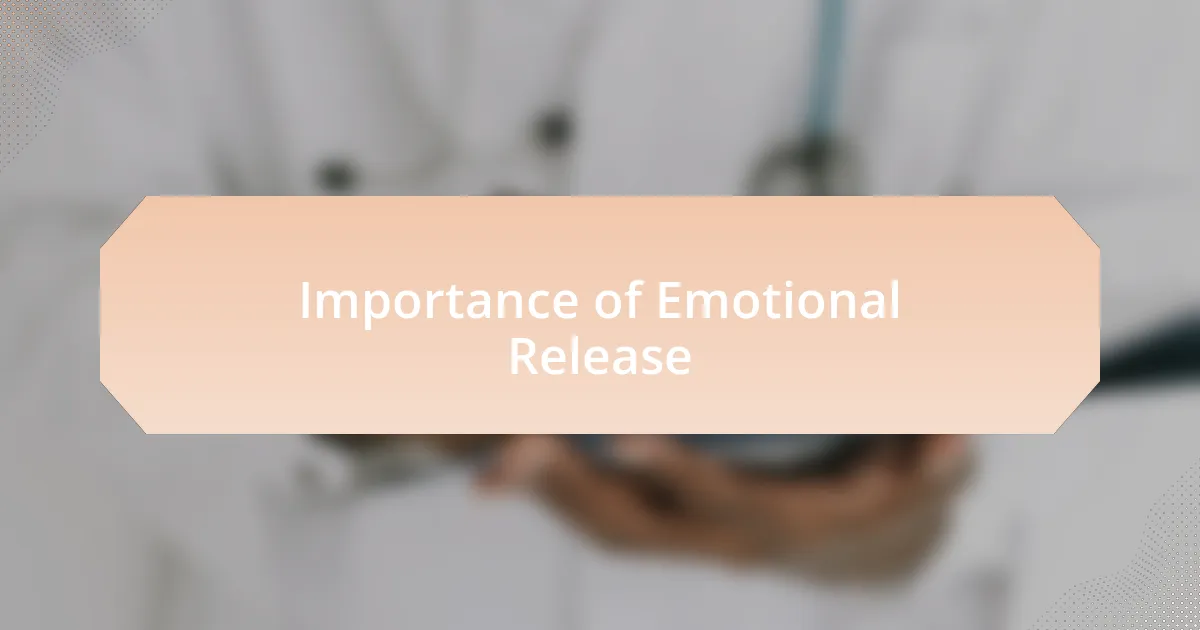
Importance of Emotional Release
Emotional release is vital for mental and spiritual well-being, particularly in a hospital setting. I’ve seen firsthand the impact of allowing feelings to surface, often during moments of vulnerability. For instance, when I was visiting a patient who had been grappling with a terminal diagnosis, we shared tears and laughter. This release transformed the atmosphere and allowed for moments of genuine connection, both between us and with God.
The act of expressing emotions can lead to significant healing. In my experience, when individuals open up about their fears and pain, they often find a sense of relief. I remember a session where a patient shared feelings of anger about their illness. Just giving voice to those frustrations seemed to lighten the emotional load they carried. It’s remarkable how sharing vulnerabilities fosters healing and creates space for hope.
Moreover, emotional release can often lead to profound insights. I once encountered a nurse who, after listening to a patient’s fears about their impending surgery, noted the patient began to see their situation in a new light. Asking simple questions about how they felt allowed the patient to reflect, shifting from fear to a sense of empowerment. Have you ever noticed how discussing our deepest concerns can change our perspective? It’s a transformative process that underscores the importance of emotional release in healing journeys.

Role of Faith in Healing
Faith can significantly contribute to emotional healing, especially in difficult moments. I recall one particular instance where a patient, feeling overwhelmed and alone, found solace in prayer. As they spoke to God, the heaviness they carried seemed to lift, reminding me of how faith can offer comfort and hope when life feels most daunting.
In my experience, faith acts as a bridge between suffering and understanding. There was a time when I accompanied a family as they dealt with the loss of a loved one. Through their shared prayers and reflections, they found a collective strength, illustrating how faith can unify and support healing. Doesn’t it make you think about how a strong belief can help us navigate the most heartbreaking times?
I’ve seen that when individuals lean into their faith, it often creates a safe space for emotional release. One patient shared how reading scripture brought clarity during their treatment. It felt as if those words offered a guiding light, allowing them to articulate their fears with a sense of peace. How powerful it is to see faith not just as belief, but as a tangible source of strength in the healing process!
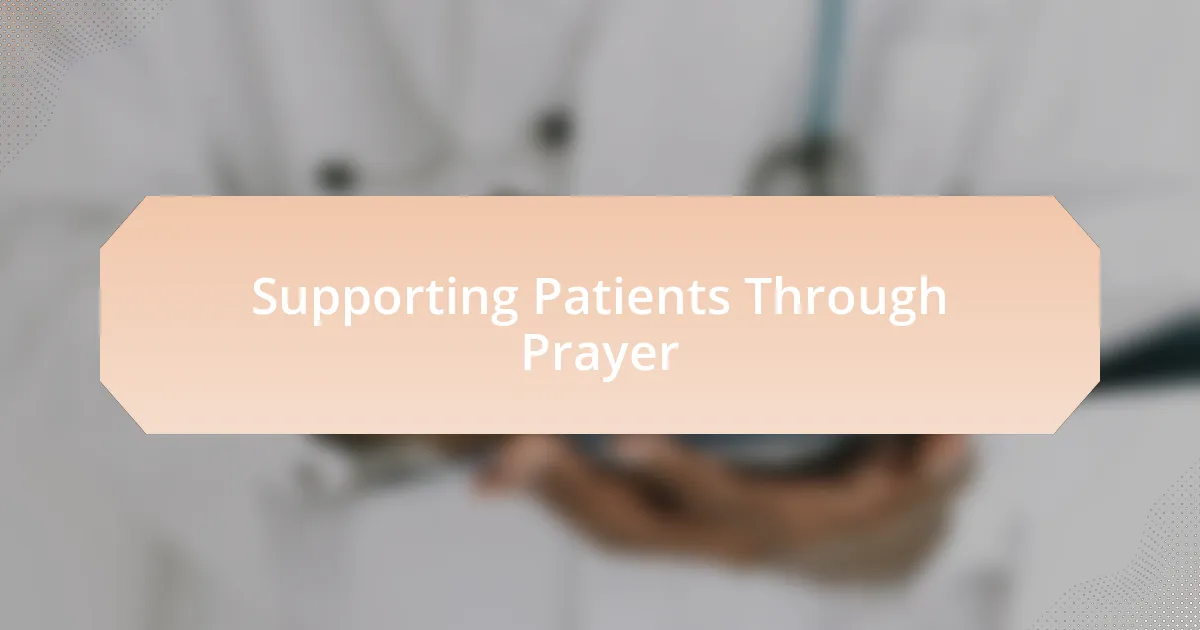
Supporting Patients Through Prayer
Supporting patients through prayer can create an unmatched sense of connection and relief. I remember sitting with a young woman before her surgery, her anxiety palpable. As we prayed together, I could see her shoulders relax, and it struck me how that simple act of reaching out to a higher power provided her with a profound sense of calm. Isn’t it incredible how prayer can serve as a balm for fear?
In another instance, I witnessed a group of patients come together for a prayer meeting. Each person shared their burdens and hopes, and I could feel the collective energy shift toward something hopeful. It was as though, through their prayers, they were not only lifting their own spirits but also supporting one another in their journeys. How often do we underestimate the power of community and shared faith to foster emotional resilience?
There are times when I’ve observed patients begin their day with a moment of silent prayer, even in the hustle of a hospital environment. One gentleman, facing a particularly challenging diagnosis, told me how that quiet time allowed him to confront his fears head-on. He expressed, “It’s like I’m having a conversation with my worries, and somehow, that makes them feel smaller.” Isn’t it fascinating how such moments of contemplation can ignite a sense of empowerment in the face of adversity?
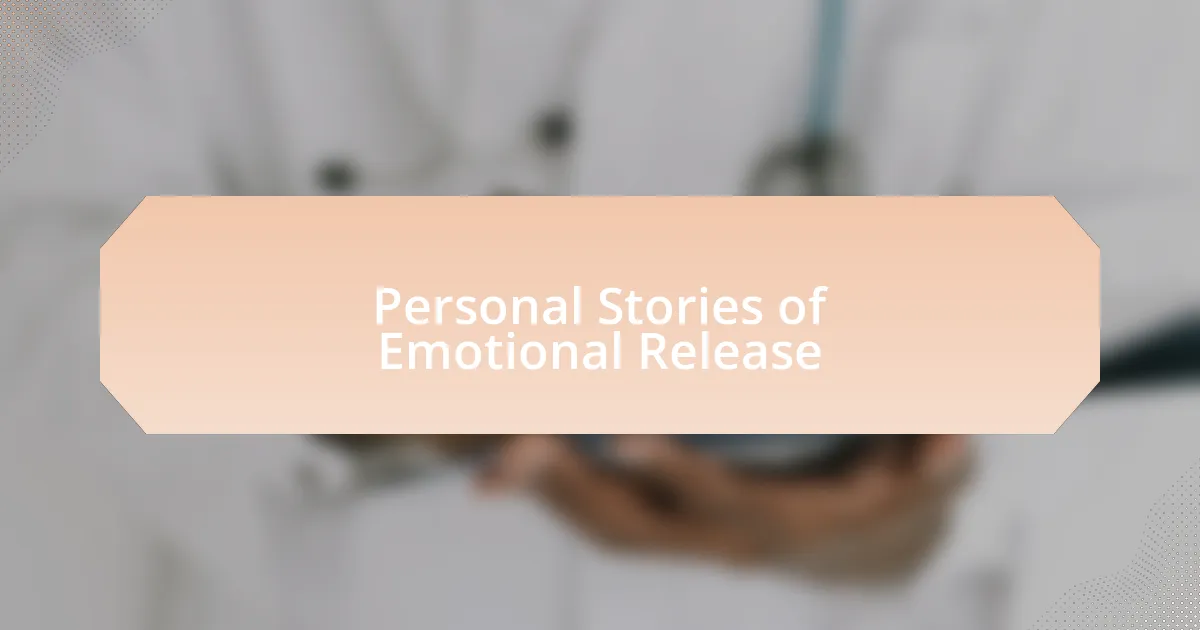
Personal Stories of Emotional Release
One day, I met an elderly man who had been battling loneliness during his hospital stay. We talked about his life, and his eyes filled with tears as he recounted stories of his late wife. I could sense a shift in him as he shared those memories; it was as if letting go of that pain through words allowed him to breathe a bit easier. How often do we overlook the healing power of simply sharing our stories?
In a group session, a woman broke down while recounting her struggle with a cancer diagnosis. As tears streamed down her cheeks, I realized the cathartic release she experienced in front of a supportive audience was transformative. It made me think about how essential it is for us to create safe spaces where vulnerability is not just accepted but embraced. Isn’t it amazing how expressing deep-seated emotions can bring about a sense of relief and community?
During a late-night visit, I sat with a father whose child was in critical condition. He shared his fears and worries, and I noticed that every word he uttered seemed to lighten his burden, even just a little. After our conversation, I saw a glimmer of hope in his eyes for the first time that evening. It reminded me of a simple truth: sometimes, in the darkest moments, releasing our emotions can illuminate a path forward.
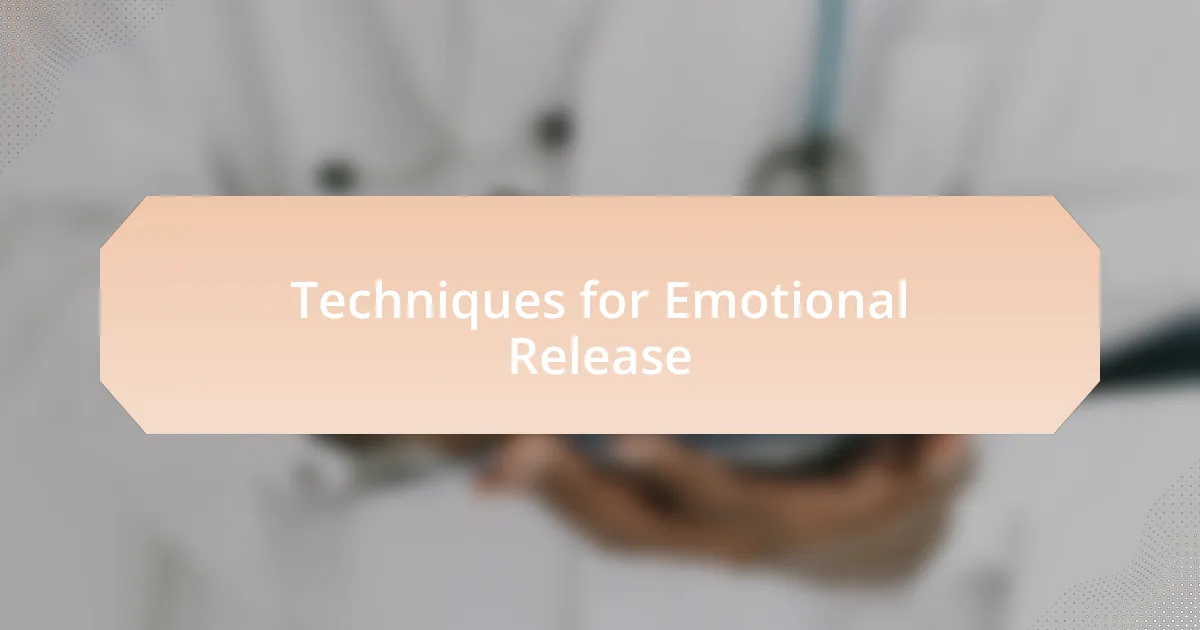
Techniques for Emotional Release
One effective technique for emotional release that I’ve found invaluable is the practice of journaling. There’s something incredibly liberating about putting pen to paper, allowing my thoughts and feelings to flow without judgment. I remember one night, grappling with frustration and fear, I wrote for what felt like hours. By the end, I had transformed chaotic emotions into coherent insights, and I slept more soundly, as if I had unloaded a heavy backpack I’d been carrying for too long.
Another powerful method is deep breathing exercises. In moments of anxiety, I often find it helps to step outside for a breather—literally. I recall a time in a bustling hospital corridor when the weight of impending loss felt suffocating. I took a few deep breaths, counting to four on the inhale and six on the exhale. It was remarkable how this simple act eased my racing heart and created a bubble of calm in the storm. Have you ever tried just breathing your way through a moment? It can be surprisingly grounding.
Lastly, engaging in creative outlets like art or music can serve as a profound means of emotional release. I once attended a session where patients were encouraged to paint what they felt. Watching them transform their pain into vibrant colors was awe-inspiring—it transformed heavy emotions into tangible expressions. I’ve often wondered if creativity unlocks something deep within us, allowing those feelings that are hard to vocalize to be expressed in a way that is uniquely personal. Isn’t it fascinating how different people find their paths to emotional release?
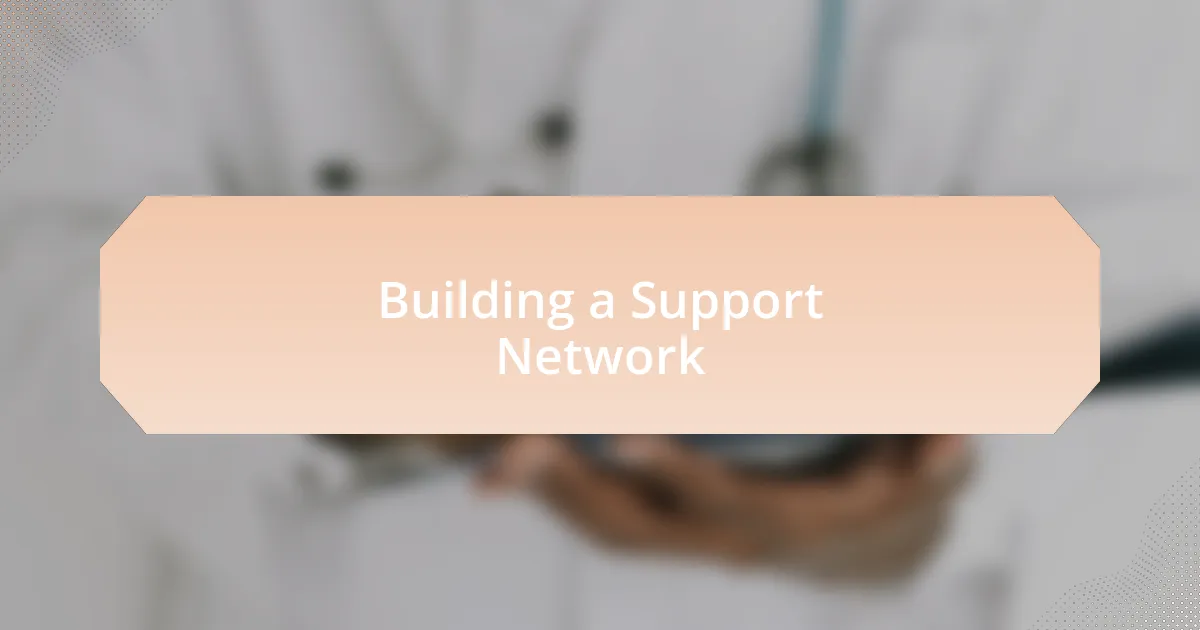
Building a Support Network
Connecting with others is essential when it comes to emotional release, and building a support network can make all the difference. I remember a particularly challenging period when I reached out to fellow volunteers in our hospital ministry. Having a group of compassionate individuals who understood the weight of our experiences made sharing my feelings feel less daunting. Have you ever noticed how simply talking with someone can lighten your emotional load?
Nurturing relationships within a support network is a continuous effort. I often find myself organizing monthly gatherings, whether for coffee or shared activities like group prayer. During these moments, I’ve seen the power of vulnerability. I think about a time when one friend openly shared her struggles, and it encouraged others to do the same. Doesn’t it amaze you how shared experiences can forge deeper connections and foster a sense of belonging?
Establishing a support network provides not just a listening ear but also shared wisdom. I’ve frequently turned to mentors within our ministry, who have guided me through tough emotional upheavals. Their insights and encouragement offered a perspective I hadn’t considered. How often do we overlook the guidance of those who have walked similar paths? Their stories and advice can be a lifeline when we’re seeking clarity amidst emotional chaos.